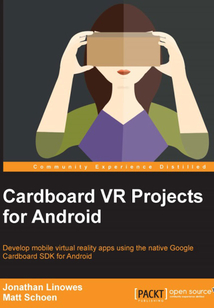舉報(bào) 

會(huì)員
Cardboard VR Projects for Android
最新章節(jié):
Index
ThebookisforestablishedAndroiddeveloperswithagoodknowledgelevelofJava.NopriorOpenGLorgraphicsknowledgeisrequired.NopriorexperiencewithGoogleCardboardisexpected,butthosewhoarefamiliarwithCardboardandarelookingforprojectstoexpandtheirknowledgecanalsobenefitfromthisbook.
目錄(137章)
倒序
- coverpage
- Cardboard VR Projects for Android
- Credits
- About the Authors
- About the Reviewers
- www.PacktPub.com
- eBooks discount offers and more
- Preface
- What this book covers
- What you need for this book
- Who this book is for
- Conventions
- Reader feedback
- Customer support
- Chapter 1. Virtual Reality for Everyone
- Why is it called Cardboard?
- The spectrum of VR devices
- A gateway to VR
- The value of low-end VR
- Cardware!
- Configuring your Cardboard viewer
- Developing apps for Cardboard
- An overview to VR best practices
- Summary
- Chapter 2. The Skeleton Cardboard Project
- What's in an Android app?
- The Android project structure
- Getting started with Android Studio
- Creating a new Cardboard project
- Adding the Cardboard Java SDK
- The AndroidManifest.xml file
- The activity_main.xml file
- The MainActivity class
- Summary
- Chapter 3. Cardboard Box
- Creating a new project
- Hello triangle!
- 3D camera perspective and head rotation
- Repositioning the triangle
- Hello cube!
- Lighting and shading
- Spinning the cube
- Hello floor!
- Hey look at this!
- Summary
- Chapter 4. Launcher Lobby
- Creating a new project
- Adding Hello Virtual World text overlay
- Using a virtual screen
- Responding to head look
- Adding an icon to the view
- Listing installed Cardboard apps
- Highlighting the current shortcut
- Using the trigger to pick and launch the app
- Further enhancements
- Summary
- Chapter 5. RenderBox Engine
- Introducing RenderBox – a graphics engine
- Creating a new project
- Materials textures and shaders
- The Math package
- The Transform class
- The Component class
- The RenderObject component
- The Cube RenderObject component
- Vertex color material and shaders
- The Camera component
- RenderBox methods
- A simple box scene
- Cube with face normals
- The Light component
- Vertex color lighting material and shaders
- Time for animation
- Detect looking at objects
- Exporting the RenderBox package
- Summary
- Chapter 6. Solar System
- Setting up a new project
- Creating a Sphere component
- A solid color lighted sphere
- Adding the Earth texture material
- Day and night material
- Creating the Sun
- Creating a Planet class
- Formation of the Solar System
- A starry sky dome
- Fine tuning the Earth
- Changing the camera location
- Possible enhancements
- Updating the RenderBox library
- Summary
- Chapter 7. 360-Degree Gallery
- Setting up the new project
- Viewing a 360-degree photo
- Viewing a regular photo
- Putting a border frame on the image
- Loading and displaying a photo image
- Loading and displaying a photosphere image
- The image gallery user interface
- Displaying thumbnails in a grid
- Gaze to load
- Enable scrolling
- Stay responsive and use threads
- An explanation of threading and virtual reality
- Launch with an intent
- Showing/hiding the grid with tilt-up gestures
- Spherical thumbnails
- Updating the RenderBox library
- Further possible enhancements
- Summary
- Chapter 8. 3D Model Viewer
- Setting up a new project
- Understanding the OBJ file format
- Creating the ModelObject class
- Parse OBJ models
- Model extents scaling and center
- I'm a little teapot
- I'm a little rotating teapot
- Thread safe
- Launch with intent
- Practical and production ready
- Summary
- Chapter 9. Music Visualizer
- Setting up a new project
- Capturing audio data
- A VisualizerBox architecture
- Waveform data capture
- A basic geometric visualization
- 2D texture-based visualization
- FFT visualization
- Trippy trails mode
- Multiple simultaneous visualizations
- Random visualizations
- Further enhancements
- Summary
- Onward to the future
- Index 更新時(shí)間:2021-07-16 10:54:32
推薦閱讀
- 24小時(shí)學(xué)會(huì)電腦組裝與維護(hù)
- Raspberry Pi 3 Cookbook for Python Programmers
- Linux KVM虛擬化架構(gòu)實(shí)戰(zhàn)指南
- Effective STL中文版:50條有效使用STL的經(jīng)驗(yàn)(雙色)
- 計(jì)算機(jī)維修與維護(hù)技術(shù)速成
- 筆記本電腦維修不是事兒(第2版)
- Large Scale Machine Learning with Python
- The Deep Learning with Keras Workshop
- Hands-On Machine Learning with C#
- 電腦高級(jí)維修及故障排除實(shí)戰(zhàn)
- Managing Data and Media in Microsoft Silverlight 4:A mashup of chapters from Packt's bestselling Silverlight books
- 單片機(jī)原理及應(yīng)用:基于C51+Proteus仿真
- Python Machine Learning Blueprints
- The Artificial Intelligence Infrastructure Workshop
- Intel FPGA權(quán)威設(shè)計(jì)指南:基于Quartus Prime Pro 19集成開(kāi)發(fā)環(huán)境
- 計(jì)算機(jī)電路基礎(chǔ)(第2版)
- Drupal Rules How-to
- Service Mesh微服務(wù)架構(gòu)設(shè)計(jì)
- 新編計(jì)算機(jī)組裝與維護(hù)
- Windows Presentation Foundation 4.5 Cookbook
- 精選單片機(jī)設(shè)計(jì)與制作30例
- Arduino Uno輕松入門(mén)48例
- Getting Started with Python for the Internet of Things
- Building Bluetooth Low Energy Systems
- Mastering Lumion 3D
- 嵌入式系統(tǒng)軟硬件協(xié)同設(shè)計(jì)實(shí)戰(zhàn)指南:基于Xilinx ZYNQ(第2版)
- Managing Multimedia and Unstructured Data in the Oracle Database
- 計(jì)算機(jī)主板維修不是事兒(第2版)
- FPGA軟件測(cè)試與評(píng)價(jià)技術(shù)
- STC單片機(jī)原理及應(yīng)用:從器件、匯編、C到操作系統(tǒng)的分析和設(shè)計(jì)(立體化教程)(第2版)

